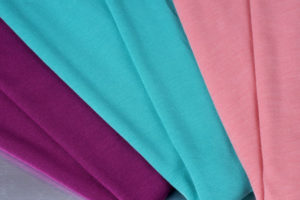 Wood pulp is used to produce viscose fabric, which many call natural synthetics. According to its consumer characteristics, it resembles cotton and linen fabrics. The natural properties of the material do not have high elasticity, therefore, for sewing clothes, elastane is introduced into it in small proportions. Modern production, due to different types of fibers and their thickness, can achieve stunning similarities with truly natural fabrics - wool, silk, linen and cotton.
Wood pulp is used to produce viscose fabric, which many call natural synthetics. According to its consumer characteristics, it resembles cotton and linen fabrics. The natural properties of the material do not have high elasticity, therefore, for sewing clothes, elastane is introduced into it in small proportions. Modern production, due to different types of fibers and their thickness, can achieve stunning similarities with truly natural fabrics - wool, silk, linen and cotton.
What is the combination of viscose and elastane
Great for sewing casual women's, men's and children's clothing, underwear and sportswear, making knitted T-shirts and sweaters, home textiles, etc.
Synthetic elastane is very durable and wear-resistant, harmoniously complementing viscose fibers, giving them increased strength and resistance to external influences.Allows clothing to fit perfectly on any figure, stretching slightly and then returning to its original shape.
Advantages:
- Pleasant tactile sensations when wearing things at any time of the year.
- It lends itself well to dyeing in any color; with proper care, it does not fade or lose the brightness of its shades.
- Does not cause allergic reactions.
- Does not accumulate static electricity, absorbs sweat, and has high hygienic properties.
- Strong and durable.
Flaws:
- It wrinkles quickly.
- Requires careful care and may shrink and become deformed during washing.
- Prone to forming pellets.
- Does not like high temperatures and exposure to ultraviolet radiation.
- Stretches with prolonged wear.
Features of care and operation
 Capricious material requires special treatment - careful washing at a temperature not exceeding 40 ° C in manual or machine mode with a delicate spin. Drying should be done without direct exposure to sunlight in a well-ventilated area or outdoors. It is best to lay the item flat on a flat horizontal surface, which will help prevent deformation of the fabric.
Capricious material requires special treatment - careful washing at a temperature not exceeding 40 ° C in manual or machine mode with a delicate spin. Drying should be done without direct exposure to sunlight in a well-ventilated area or outdoors. It is best to lay the item flat on a flat horizontal surface, which will help prevent deformation of the fabric.
Ironing should be done at low temperatures from the reverse side or through moistened gauze. It is recommended not to use the steam mode to prevent splashes and steam from leaving stains on your clothes. In any case, when purchasing products made from viscose, you must carefully study the label on the back of the item and strictly adhere to the specified recommendations.
Viscose 95% and elastane 5%
| Indicators | Texture | Elasticity and drape | Durability and durability | Wash |
| 95% viscose and 5% elastane | More elastic | Stretches very well | Can stretch | Requires a delicate attitude |
Lining fabric viscose with elastane
| Indicators | Texture | Elasticity and drape | Durability and durability | Wash |
| Lining viscose (with cotton or polyester) | More elastic | Doesn't stretch well | Does not deform when worn | Resistant to deformation |
Other fabrics
| Indicators | Texture | Elasticity and drape | Durability and durability | Wash |
| 100% viscose | Silky, smooth and pleasant to the body | Doesn't stretch well | Wears out and wrinkles quickly, easily damaged when wet | Not resistant to deformation |
| Viscose with cotton | More elastic | Doesn't stretch well | Subject to shrinkage | Not resistant to deformation |
| Viscose staple | More elastic | Draps well | Wrinkles less and does not deform when worn | Resistant to deformation |
 The average price of fabric depends on the types of compositions and the manufacturer. The main suppliers of materials are China and Uzbekistan. Domestic manufacturers present only lining fabrics on the market at a price of about 250 rubles per meter. Thin viscose fabrics can be purchased for up to 900 rubles per meter; denser ones are much more expensive.
The average price of fabric depends on the types of compositions and the manufacturer. The main suppliers of materials are China and Uzbekistan. Domestic manufacturers present only lining fabrics on the market at a price of about 250 rubles per meter. Thin viscose fabrics can be purchased for up to 900 rubles per meter; denser ones are much more expensive.
Each person has their own individual feelings for each of the above types of materials. Even if the label indicates that the composition includes 95% viscose and 5% elastane, one person may really like the items, another will not look at them anymore, and a third will make the subsequent choice more carefully. It all depends on the manufacturer, the features of the technological process and the quality of the raw materials used.
Ideally, you need to try on a product before purchasing, listen to your feelings, understand whether you like or dislike the product, whether you want to wear it and how it fits into your existing wardrobe in terms of style and color scheme. Wear comfortable and beautiful things for a long time and with pleasure!


 2
2





